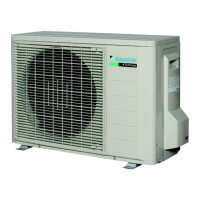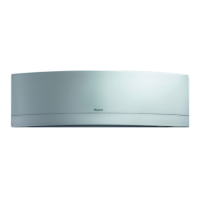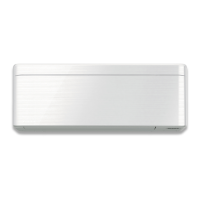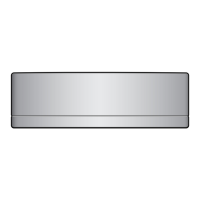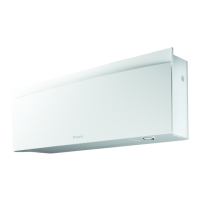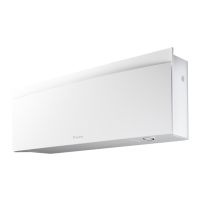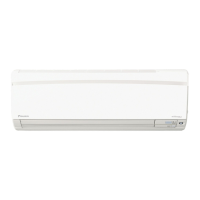
Do you have a question about the Daikin FTXJ50MV1BW and is the answer not in the manual?
| Cooling Capacity | 5.0 kW |
|---|---|
| Power Supply | 220-240V, 50Hz |
| Refrigerant | R32 |
| Outdoor Unit Noise Level | 48 dB(A) |
| Type | Split |
| Energy Efficiency Ratio (Cooling) | 3.20 |
Detects human movement for automatic energy saving operations.
Allows saving up to 4 timer settings daily according to family lifestyle.
Adjusts airflow direction for comfort and reduces outdoor unit noise.
Instructions to prevent personal injury, loss of life, property damage, or serious injury.
Specific warnings about fire, explosion, injury, and refrigerant leakage.
Precautions for unit handling, moisture impact, and environmental factors.
Guidance on installation locations, noise consideration, and electrical work.
Identifies indoor unit parts like air inlet, outlet, louvres, and display elements.
Details of multi-monitor lamp, timer lamp, and indoor unit ON/OFF switch.
Identifies outdoor unit parts like air inlet, outlet, drain hose, and sensors.
Covers signal transmitter, display, ON/OFF, and temperature adjustment buttons.
Details on FAN, POWERFUL, and other function buttons on the remote.
Functions of MODE, COMFORT/SENSOR, and ECONO/QUIET buttons.
Functions of SWING, TIMER, and CLOCK buttons for operation control.
Steps for setting batteries and fixing the remote controller holder.
Care and usage advice for the remote controller and its batteries.
The first step to power the air conditioner unit.
Steps to set the unit's internal clock for accurate timer operations.
Instructions on how to start and stop modes like AUTO, COOL, and HEAT.
Details on HEAT, COOL, DRY, AUTO, and FAN modes.
How to adjust temperature settings for different operation modes.
Ideal temperature ranges and tips for maximizing energy efficiency.
Environmental limits and conditions that may trigger safety devices.
Activating automatic airflow swing for up/down and right/left directions.
Manually stopping airflow direction at a desired position.
Steps to change the airflow rate or fan speed.
Explains flap angles, swing ranges, and effects of airflow rate.
Explains comfort airflow for direct contact prevention and intelligent eye sensors.
Benefits of the intelligent eye sensor for energy efficiency.
Using COMFORT AIRFLOW and INTELLIGENT EYE operations together.
Steps to activate COMFORT AIRFLOW and INTELLIGENT EYE combined modes.
Steps to cancel or deactivate COMFORT AIRFLOW and INTELLIGENT EYE.
Details on comfort airflow settings, limitations, and priority.
Application range and factors affecting sensor detection.
Specifics of combined features and sensor safety precautions.
Warnings about sensor placement and handling to prevent damage.
Steps to start and cancel the POWERFUL operation mode.
Notes on limitations, unavailable functions, and mode effects.
Limits maximum power consumption for efficient operation.
Reduces outdoor unit noise by changing frequency and fan speed.
Steps to start and stop EconO and Outdoor Unit Quiet modes.
Details and limitations of EconO and Quiet operation modes.
Steps to configure and remove the OFF TIMER function.
General timer operation notes and the NIGHT SET mode for sleep.
Steps to configure and remove the ON TIMER function.
Example of combining ON TIMER and OFF TIMER settings.
Conditions that require the timer settings to be reset.
Demonstrates setting schedules for weekdays and weekends.
Step-by-step guide to configure weekly timer schedules.
Visual progression of setting the weekly timer on the remote.
Steps to set the desired time and temperature for weekly timer.
Final steps for confirmation and activating the weekly timer.
Notes on priority, reset conditions, and ON/OFF timer interaction.
Steps to copy settings from one day to another.
Details and notes on copying reservations for the weekly timer.
Steps to view and confirm scheduled weekly timer reservations.
Steps to turn off the weekly timer function.
Steps to remove specific or daily scheduled timers.
How to clear all scheduled weekly timers.
How operation modes are managed across multiple indoor units.
Specific modes for multi-systems concerning night noise and unit quietness.
Forcing a single COOL or HEAT mode across all connected units.
How the priority room setting influences operation in other rooms.
Quick reference for cleaning the unit's panels and filters.
Detailed steps for cleaning the front panels and standard air filters.
Instructions for cleaning the titanium apatite photocatalytic air-purifying filter.
List of materials and substances to avoid during cleaning.
Detailed procedure for removing, washing, and drying air filters.
Safety warning regarding handling air filters during removal or mounting.
Steps for removing, cleaning, or replacing the titanium filter.
Important notes on filter condition, replacement, and ordering.
Essential checks of the unit and its fittings before operation.
Steps for drying the unit and preparing it for storage.
Recommendations for professional maintenance and refrigerant details.
Explains common sounds that are not indicative of a fault.
Addresses flap movement, airflow stops, and operation start delays.
Explains why the outdoor unit might emit water or steam.
Identifies non-fault conditions and basic checks before calling for service.
Diagnosing issues when the unit doesn't start or stops unexpectedly.
Troubleshooting low cooling/heating effects and abnormal operations.
Problems related to front panels not opening and mist generation.
Issues with heat operation start delay and outdoor fan rotation.
Troubleshooting timer settings and indoor unit odors.
Problems with remote operation and heat mode selection.
Symptoms requiring urgent professional attention and service calls.
Actions to take during power outages and lightning strikes.
Guidelines for responsible disposal of the product and batteries.
How to retrieve error codes from the remote controller for fault diagnosis.
Explanation of LED status lights on the outdoor unit PCB for different series.

